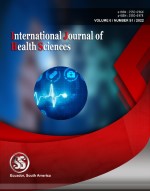Histopathological findings of umbilical cord in intrauterine growth restriction
Keywords:
intrauterine growth restriction, histopathology, Wharton’s jelly oedema, venous dilatationAbstract
Background: Intrauterine growth restriction is one of the causes of perinatal mortality and morbidity. Intrauterine growth of fetus depends on maternal, fetal and genetic factors. Aim of the study was to find the histopathology of umbilical cord in IUGR and normal pregnancies. Materials & methods: This prospective case control study included 100 umbilical cord samples which were equally distributed as cases and control. Routine histological procedures were followed for staining of tissue. Histopathology readings were photographed and noted. Results: In our study we found 24 % Wharton’s jelly oedema and 28 % venous dilatations in IUGR. We didn’t observe any thrombus, fibrinoid necrosis, perivascular or intraparietal hemorrhage, arterial or venous thrombus in our study both in cases and control. Conclusion: Umbilical cord and placental histopathology provides insight to predict reoccurrence of IUGR and for timely management.
Downloads
References
Jakó M, Surányi A, Kaizer L, Németh G, Bártfai G: Maternal Hematological Parameters and Placental and Umbilical Cord Histopathology in Intrauterine Growth Restriction. Med Princ Pract 2019;28:101-108. doi: 10.1159/000497240.
Benirschke K, Burton GJ, Baergen RN. Pathology of the Human Placenta. 6th ed. Springer; 2012. https://doi.org/10.1007/978-3-642-23941-0
Odibo AO, Zhong Y, Longtine M, Tuuli M, Odibo L, Cahill AG, et al. First-trimester serum analytes, biophysical tests and the association with pathological morphometry in the placenta of pregnancies with preeclampsia and fetal growth restriction. Placenta. 2011 Apr;32(4):333–8.
Ducray JF, Naicker T, Moodley J. Pilot study of comparative placental morphometry in pre-eclamptic and normotensive pregnancies suggests possible maladaptations of the fetal component of the placenta. Eur J Obstet Gynecol Reprod Biol. 2011 May;156(1):29–34.
Reynolds, L. P. et al. Evidence for altered placental blood flow and vascularity in compromised pregnancies. J. Physiol. 572, 51–58 (2006).
Hendrix, N. & Berghella, V. Non-placental causes of intrauterine growth restriction. Semin. Perinatol. 32, 161–165 (2008)
Bamfo, J. E. & Odibo, A. O. Diagnosis and management of fetal growth restriction. J.Pregnancy 2011,640715. https://doi.org/10.1155/2011/640715 .
THOMLON, L. L.; HOO J. J. Linear disruption of umbilical cord: a rare anomaly of the cord associated with acute fetal distress and perinatal death/profound psychomotor retardation. Am J Med Genet, v. 62, n. 4, p. 348-9, 1996.
KULKARNI, M. L. et al. Absence of Wharton's Jelly around the umbilical arteries. Indian J Pediatr, v. 74, n. 8, p. 787-9, 2007.
Oliveira CC, Dufloth RM, Coelho KI. Absence of Wharton's jelly: case report. Jornal Brasileiro de Patologia e Medicina Laboratorial. 2014 Dec;50(6):452-5.
Rolschau J. The relationship between some disorders of the umbilical cord and intrauterine growth retardation. Acta Obstet Gynecol Scand Suppl. 1978;72:15-21. PMID: 274057.
Byers, B.D., Goharkhay, N., Mateus, J., Ward, K.K., Munn, M.B. and Wen, T.S. (2009), Pregnancy outcome after ultrasound diagnosis of fetal intra-abdominal umbilical vein varix. Ultrasound Obstet Gynecol, 33: 282-286. https://doi.org/10.1002/uog.6233
Mahony BS, McGahan JP, Nyberg DA, Reisner DP. Varix of the fetal intra-abdominal umbilical vein: Comparison with normal. J Ultrasound Med. 1992;11:73–6.
Lee SW, Kim MY, Kim JE, Chung JH, Lee HJ, Yoon JY, et al. Clinical characteristics and outcomes of antenatal fetal intra-abdominal umbilical vein varix detection. Obstet Gynecol Sci. 2014;57:181–6.
Shah KH, Nambiyar R, Bhat S. Prenatal diagnosis and management of fetal intra-abdominal umbilical vein varix. J Family Med Prim Care. 2018 Mar-Apr;7(2):458-460. doi: 10.4103/jfmpc.jfmpc_76_17. PMID: 30090795; PMCID: PMC6060947.
Mankuta D, Nadjari M, Pomp G. Isolated fetal intra-abdominal umbilical vein varix: Clinical importance and recommendations. J Ultrasound Med. 2011;30:273–6.
Bas-Lando M, Rabinowitz R, Samueloff A, Latinsky B, Schimmel MS, Chen O, et al. The prenatal diagnosis of isolated fetal varix of the intra-abdominal umbilical vein is associated with favorable neonatal outcome at term: A case series. Arch Gynecol Obstet. 2013;288:33–9.
Lutfallah F, Oufkir N, Markou GA, Frimigacci D, Poncelet C. A Case of Umbilical Artery Thrombosis in the Third Trimester of Pregnancy. Am J Case Rep. 2018 Jan 19;19:72-75. doi: 10.12659/ajcr.906859. PMID: 29348396; PMCID: PMC5785950.
Klaritsch P, Haeusler M, Karpf E, Schlembach D, Lang U. Spontaneous intrauterine umbilical artery thrombosis leading to severe fetal growth restriction. Placenta. 2008 Apr;29(4):374-7. doi: 10.1016/j.placenta.2008.01.004. Epub 2008 Mar 4. PMID: 18289672.
Heifetz SA. Thrombosis of the umbilical cord: analysis of 52 cases and literature review. Pediatr Pathol. 1988;8(1):37-54. doi: 10.3109/15513818809022278. PMID: 3041394.
Blanco MV, Vega HR, Guerri-Guttenberg RA, Giuliano R, Grana DR, Azzato F, Milei J. Histopathology and histomorphometry of umbilical cord blood vessels. Findings in normal and high-risk pregnancies. Artery Research. 2011 Jun 1;5(2):50-7.
Published
How to Cite
Issue
Section
Copyright (c) 2022 International journal of health sciences

This work is licensed under a Creative Commons Attribution-NonCommercial-NoDerivatives 4.0 International License.
Articles published in the International Journal of Health Sciences (IJHS) are available under Creative Commons Attribution Non-Commercial No Derivatives Licence (CC BY-NC-ND 4.0). Authors retain copyright in their work and grant IJHS right of first publication under CC BY-NC-ND 4.0. Users have the right to read, download, copy, distribute, print, search, or link to the full texts of articles in this journal, and to use them for any other lawful purpose.
Articles published in IJHS can be copied, communicated and shared in their published form for non-commercial purposes provided full attribution is given to the author and the journal. Authors are able to enter into separate, additional contractual arrangements for the non-exclusive distribution of the journal's published version of the work (e.g., post it to an institutional repository or publish it in a book), with an acknowledgment of its initial publication in this journal.
This copyright notice applies to articles published in IJHS volumes 4 onwards. Please read about the copyright notices for previous volumes under Journal History.
















